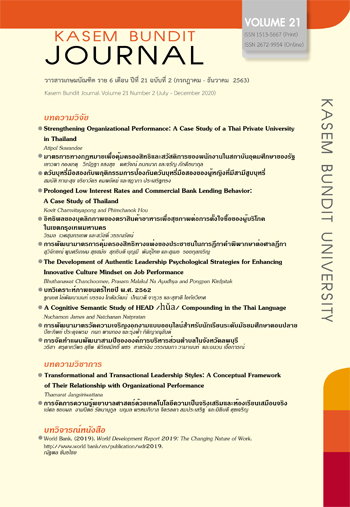การศึกษาคุณสมบัติทางอรรถศาสตร์ของคำว่า ‘หัว’ ในภาษาไทย
คำสำคัญ:
อุปลักษณ์, นามนัย ภาษาไทย, หัว, อรรถศาสตร์ปริชานบทคัดย่อ
บทคัดย่อ
วัตถุประสงค์ เพื่อศึกษาคุณสมบัติทางอรรถศาสตร์ของคำว่า “หัว” ในภาษาไทยโดยใช้แนวความคิดอรรถศาสตร์ปริชานซึ่งเป็นวิธีการศึกษาภาษาที่สะท้อนมโนทัศน์ผ่านระบบปริชานของมนุษย์ วิธีการวิจัย ดำเนินการวิจัยโดยใช้แนวความคิดอรรถศาสตร์ปริชานโดยเฉพาะกระบวนการทางอุปลักษณ์และนามนัยซึ่งสามารถนำมาใช้ทำความเข้าใจความหมายและอธิบายการขยายความหมาย เพื่อแสดงให้เห็นความสัมพันธ์ระหว่างความหมายพื้นฐานกับความหมายต่าง ๆ ที่ขยายออกไป แนวความคิดดังกล่าวจะนำมาใช้ศึกษาความสัมพันธ์ระหว่างความหมายพื้นฐานของคำว่า “หัว” กับความหมายต่าง ๆ ที่ขยายออกไปจากความหมายพื้นฐาน งานวิจัยนี้ เก็บข้อมูลคำว่า “หัว” ที่เป็นคำประสมเท่านั้น โดยรวบรวมจากคลังข้อมูลภาษาไทยแห่งชาติ ปี พ.ศ. 2541-2560 ผลการวิจัย คำประสมของคำว่า “หัว” มีทั้งหมด 497 คำ คำว่า “หัว” มีทั้งหมด 14 ความหมายที่มีความเกี่ยวข้องกัน ซึ่งทั้ง 14 ความหมายนี้รวมถึงความหมายพื้นฐานด้วย สรุป คำว่า “หัว” เป็นคำที่จัดได้ว่าเป็นคำหลายความหมายอย่างแท้จริง
ดาวน์โหลด
เผยแพร่แล้ว
รูปแบบการอ้างอิง
ฉบับ
ประเภทบทความ
สัญญาอนุญาต
ทัศนคติ ความคิดเห็นใด ๆ ที่ปรากฏในวารสารเกษมบัณฑิตฉบับนี้เป็นของผู้เขียน โดยเฉพาะ มหาวิทยาลัยเกษมบัณฑิตและบรรณาธิการ ไม่จำเป็นต้องมีความเห็นพ้องด้วย







